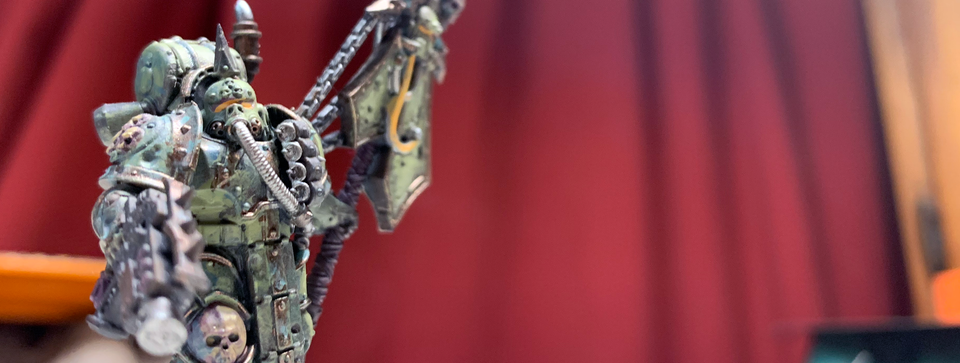Bearing the Banner of Decay: Death Guard and Stoic Resilience

“Let death and exile, and all other things which appear terrible, be daily before your eyes... and you will never entertain any abject thought, nor too eagerly covet anything.”
- Epictetus, Enchiridion[1]
There’s a figure on my desk. Still in parts. A standard bearer. Death Guard.
I haven’t assembled him yet. Haven’t cleaned the sprue or planned a scheme. But there’s something about him - this warrior whose whole purpose is to carry a flag - that has made me pause.
Because, truthfully, I don’t understand him.
Not yet.
In a world where every piece is geared toward action, killing, or survival, he does none of those things. He holds. He stands. He becomes a visible symbol in a place designed to destroy symbols.
And that has stopped me.
It reminds me of something older than fiction - something quieter than war. The ancient practice of carrying death with you not as a burden, but as a guide. The Stoic principle of memento mori.
Before this figure transforms from plastic and pigment to a completed miniature, he’s become a question.
What does it mean to carry something instead of fight? What does it mean to be a standard bearer in a time that no longer uses them? And have we, in gaining distance from death, lost the clarity it used to give us?
This is not a meditation on tactics. Or lore. Or paint. It’s a meditation on what it means to stand for something - and to do so visibly, even when it costs you everything.
II. Without Panic
Memento mori.
Remember you must die.
The phrase is older than it sounds now. Roman, mostly. But like many ideas that survive too long in quotes and thumbnails, it’s been flattened—turned from reflection into branding.
Once, it was a practice. A way of carrying death—not morbidly, not dramatically—but steadily.
“Let death and exile, and all other things which appear terrible, be daily before your eyes... and you will never entertain any abject thought, nor too eagerly covet anything.”
— Epictetus, Enchiridion[1:1]
It wasn’t nihilism. It was focus.
“You could leave life right now. Let that determine what you do and say and think.”
— Marcus Aurelius, Meditations[2]
For the Stoics, death wasn’t an interruption. It was the frame. The final shape that made the present one visible.
“To study philosophy is to learn to die.”
— Cicero, Tusculan Disputations[3]
And yet, even as I write this, I feel the tension. Because Stoicism, in the modern world, is everywhere. Quote accounts. Cold showers. Grindset podcasts. Austerity, with a side of merch.
It’s easy to signal it. Much harder to sit with it.
So this is not a declaration of alignment. It’s a pause. A small meditation.
Because this part of it—the idea that we carry death not in fear but in awareness—still matters to me.
And maybe that’s what this model is trying to tell me: That to carry a banner might once have meant more than it does now. Not to direct battle. But to remind others: this still matters.
III. A Body That Reminds
Historically, the standard bearer played a vital role in battle—not just ceremonial, but practical. The flag marked the unit’s position, serving as a visual anchor in the chaos. Troops were ordered to stay close to it to maintain cohesion, and commanders could direct formations simply by repositioning the standard[4].
In the chaos of smoke and steel, the banner told you where your people were. It marked the line. It held the centre. If the standard stood, the fight could still be won.
And so the bearer became something more than a soldier. They were the anchor. The signpost. The visible core of whatever remained unbroken.
It was a position of honor—but also one of exposure. To carry the standard was to become the target. Because if the symbol fell, morale followed.
When the standard stood, the line held. When it fell, everything else began to unravel.
Modern warfare moves invisibly: encrypted channels, thermal vision, remote coordination. No one carries a flag into battle anymore.
And yet, the role survives—just not in combat. We still see standard bearers at funerals. In parades. In memory.
They’ve become symbolic, not strategic.
We call them colour guards. They don’t guide motion. They hold meaning. They walk slowly, with deliberate presence, not because the flag is heavy—but because what it stands for is.
They don’t point the way forward. They remind us what it cost to get here.
So maybe what’s disappeared is not the need for standards, but the risk of embodying them. Today’s soldiers still fight for ideals - but they don’t carry them physically into the firefight.
Not in speech. Not in philosophy. Just in presence. A body, holding meaning where others have fallen silent.
We still need reminders. We just don’t always put them in people’s hands anymore.
IV. When Meaning Is No Longer Carried
We no longer assign people to embody the symbol. We abstract meaning. We distance it from the human form. And maybe, in doing so, we lose something?
There is something raw and powerful about a person holding the standard. A body becoming the symbol. A soldier saying: This flag may fall, but not while I breathe.
We don’t have that anymore. Because it’s too costly. Too exposed.
And maybe that’s part of what the Death Guard - or the old philosophies - ask us to remember:
That to be human is to carry meaning in the flesh, not just in the abstract.
For most of human history, death was proximate: You buried your family. You washed the body. You saw people die in childbirth, in battle, from disease. And when you fought in war, you saw your enemy’s eyes. You heard the breath leave their lungs.
Death was visceral. Present. Part of life.
And so people developed rituals to hold it. Symbols. Words. Flags. Stones. Prayers. They carried death - literally and figuratively - with them. Memento mori wasn't a slogan. It was reality.
Today, we live longer. We die in hospitals, under sedation. We outsource mourning to professionals. We sanitise. Euphemise. Compartmentalise.
Death is rarely seen, and even more rarely touched.
So we don't remember it the same way. We don't carry it. We delegate it.
And just as no one is a standard bearer in battle anymore, few of us are carriers of memory in daily life.
The modern person has no flag in hand, and no skull on the desk.
Death is outsourced. Symbols are abstract.
And meaning becomes thin.
We no longer see banners raised in the field, just as we no longer keep death near at hand. Both have become abstract—death hidden behind medical systems, banners behind ceremony. In war, we’ve removed the visible symbol. In life, we’ve removed the visible end.
And yet both once served the same purpose: to guide.
The banner bearer stood not for glory, but to give shape to the chaos—so others would know where they stood. Memento mori serves the same role in life. It doesn’t command. It reminds. Not to fear death, but to live with purpose—to orient ourselves when everything else begins to fray.
The banner says, “Here is the centre.” The whisper of death says, “This is why it matters.”
“It is not that we have a short time to live, but that we waste much of it.”
- Seneca
IV. To Stand and Hold
And as I sat with this model, I began to understand—this isn’t just a miniature. It’s a process. A quiet construction of something we no longer carry in the open.
We don’t bear standards anymore. Not in war. Not in life. We don’t look death in the eye—we delegate it. Delay it. Forget it.
But here, in this small act of assembly, I’m building a reminder.
A memento.
He won’t win battles. But he will stand. And in standing, he might say something we’ve stopped saying:
That this mattered. That we were here. That death was not a thing to run from—but something to carry, carefully, so others remember what was worth living for.
And maybe that’s the role now. Not to kill. Not to lead. But to remind.
A body that holds a symbol, even when the world forgets what it’s for.
https://www.azquotes.com/quote/567093
Archive: Internet Archive ↩︎ ↩︎https://dailystoic.com/you-could-leave-life-right-now-let-that-determine-what-you-do-and-say-and-think/
Archive: Internet Archive ↩︎https://monadnock.net/montaigne/learn.html
Archive: Internet Archive ↩︎https://en.wikipedia.org/wiki/Standard-bearer#Role
Archive: Internet Archive ↩︎

